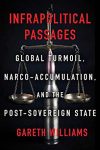Esto que sigue, junto a un post anterior sobre Infrapolítica. Instrucciones de uso (2020) busca formar, a la larga, un bosquejo de un texto más largo sobre algunos de los libros de Alberto Moreiras.
***
La nueva edición de Tercer espacio y otros relatos (2021) de Alberto Moreiras agrega bastante a la edición de 1999. Todo esto, por supuesto, está comentado por Moreiras mismo. Se puede decir que Línea de sombra. El no sujeto de lo político (2021) y Tercer espacio son una reexposición de una herida. Si las cosas ya iban hace más de veinte años, como Moreiras escribe, analiza, tematiza y comenta en ambos libros, ahora las cosas van peor. De ahí que, el testimonio de Moreiras, “testimonio de una vida parcialmente dedicada a la observación y estudio de formas de escritura salvaje y subversiva” (Tercer espacio 10) valga mucho la pena. Reeditar Tercer espacio no sólo muestra una necesidad de volver a algo que ya estaba antes de las elaboraciones sobre la infrapolítica, la poshegemonía, la desnarrativización u otros conceptos claves de y para Moreiras, sino que también, quizás, aquello que precede también excede. Esto es, “la acumulación de intereses puntuales que seguían su propia lógica” (10) y que formó a ambas ediciones de Tercer espacio siga en expansión, que la acumulación de escritura salvaje y subversiva antecede y precede al tercer espacio y a la posibilidad misma de relatar. Más aún, esa acumulación es el testimonio de una vida que late por esa herida expuesta. Así, la nueva edición de Tercer espacio invita a la lectura, al diálogo y a la discusión. Si hace 20 años el libro “herético” de Moreiras, como lo llama Gareth Williams en el “Prólogo,” no encontró nicho y resonancia en el mundo académico tradicional, quizás esta vez sea diferente. Quizás.
Las dos partes en que se divide Tercer espacio ofrecen ensayos sobre diversos autores latinoamericanos, mayormente. La primera parte es la reedición de la edición de 1999 y la segunda son los otros relatos que anuncia el título del libro, artículos que aparecieron en diversas revistas académicas. A su vez, hay una “Nota preliminar,” un “Prólogo” escrito por Gareth Williams, una “Coda” y “Apéndices.” En el “Prólogo,” Williams recupera una cita clave para entender cómo está escrito Tercer espacio. El libro está escrito a partir de tres registros que siguen un plan para llegar a “una meditación concreta sobre la mímesis o práctica del duelo.” Los tres registros son: “el registro de la literatura latinoamericana a ser estudiada, el registro teórico propiamente dicho, y el otro registro, más difícil de verbalizar o presentar, registro afectivo del que depende al tiempo la singularidad de la inscripción autográfica y su forma específica de articulación trans-autográfica, es decir, su forma política” (25). Literatura, teoría y afecto supondrían también pensar en tres espacios. El tercer espacio es el espacio del afecto, del duelo. Tal vez, sin que el libro se preocupe mucho de ello, no queda suficientemente claro por qué es el duelo el principal afecto que mueve la “práctica del residuo o del resto ontológico en la escritura” (32). Si todos los textos analizados en Tercer espacio cargan con “una experiencia básica o extrema de pérdida del fundamento” (33), esto no quiere decir que el duelo sea suficiente para entender cómo los textos hacen “de la pérdida el lugar de cierta recuperación, siempre precaria e inestable, pues siempre constituida sobre un abismo” (33). Es decir, si ese resto enigmático (término que se usa en Línea de sombra para hablar del no sujeto de lo político) que persiste luego de la pérdida se expone al mundo y se engancha a la existencia de forma precaria e inestable, difícilmente el duelo puede atraparlo, pues más que resistencia, la persistencia del residuo duele tanto como alegra cualquier otro afecto de valencia positiva.
En el tercer espacio habitan los restos, los residuos, aquello que se escapa. Como en la foto del niño y su madre (Fig. 1), en la dualidad y la repetición algo se escapa a la posibilidad reflejante del espejo, sólo la cámara “capta desde detrás la escena de este cruce de miradas que no se cruzan” (41). Una traza sin cruce, eso sería una posible definición del tercer espacio. En palabras de Moreiras al respecto de la foto, “hay un tercer espacio, definido por la fisura que separa las dos miradas y que bloquean su encuentro, definido por la fisura que, al postergar en ansiedad paciente la posibilidad de encuentro, vincula, pero sólo tentativa, hipotéticamente, el espacio primero y el espacio segundo —los vincula al tiempo que los separa tenue e infinitamente” (40). Esa fisura demanda explicación, pero no admite resolución explicativa. A la vez, por esa fisura y esa serie de reflejos, el vinculo hipotético que también separa tenue e infinitamente deja ver el residuo de los ojos y de lo que estos comprueban. Así, aquello que las manos de la madre y del niño sostuvieron, ya no se puede sostener más, sino por la mirada. En ese sostenerse mutuo se aviva “un oscuro goce” (42).
Con esto, se insiste en que, a pesar de que el libro enfatice la labor del duelo como producción negativa para salvaguardar el residuo de aquello que persiste, el duelo no puede cargar con todo lo que el residuo desborda. Si el duelo es otra cosa cuando se duele de sí mismo, pues “el verdadero odio está en la narrativa, porque la narrativa no es aquí más que pretexto para buscar en ella momentos constituyentes de desnarrativización, los momentos en los que la historia y las historias se hacen indistinguibles de su propio desastre” (42). El duelo en su momento de desnarrativización, en el que su dolor se hace indistinguible de su propio sufrimiento, libera aquello que le aquejaba. Todo esto, parecería contraproducente, pues el libro siempre regresa a la necesaria labor negativa que el duelo precisa y, de cierta manera, a la imposibilidad de que otros afectos puedan dejar resonar aquello que el residuo enigmático guarda. Sin embargo, en casi todas las lecturas a los textos literarios, se tiene prueba de lo contrario. En la lectura de “Tlön, Uqbar, Orbis Tertius” de Jorge Luis Borges (“Capítulo segundo”), la escritura postsimbólica sirve para plantear eso que precede y excede al duelo. El cuento de Borges, al final, se trata de cómo “los epitafios traducen la muerte y así articulan una especie de supervivencia” (68). Esa supervivencia esta directamente relacionada con la escritura postsimbólica. Esta forma de escritura sucede porque en Tlön no hay forma de substantivación, porque el mundo “ha de ser entendido antirrepresentacional y antisimbólicamente” (71). Así, la escritura postsimbólica “vive en el duelo de sí misma. Sobrevive en una indecisa labor de traducción cuya precariedad sin embargo acoge la alegría de saberse fiel a sí misma, siguiendo su propia ley” (73). Esa alegría que se acoge es la que precisamente nunca puede llegar a afirmarse (74). Borges es un escritor del tercer espacio, como se verá en otros capítulos del libro, porque su escritura no es exterior ni interior, “su espacio es el espacio tercero de una extraña posibilidad de traducción del mundo” (74). En esa extraña posibilidad no hay ya duelo, pero sí una inafirmable alegría, tal vez. Si la aflicción busca aquello que deja traza y murmura, aquello que deja sólo un rumor, ¿por qué se duele tanto la aflicción por no ver pero seguir oyendo, seguir sintiendo?
La negatividad es inescapable, tal vez. Se dice sobre la negatividad, al respecto de “Funes el memorioso” que:
funciona como instancia crítica e irónica: la nostalgia de presencia, si bien no puede presentar sus propios resultados positivos, articula al menos bajo el modo de la alusión el proyecto de una posición privilegiada donde coincidirían racionalidad y creación, y en la que sería posible asentar la relevancia emancipatoria del arte. No importa que esa posición no pueda ser más que proyectada. El vacío que crea la acción misma de proyectar es un vacío activo (116).
Todo esto va de acuerdo con el carácter funesto de Funes, su inescapable vida de “auto-coincidencia instantánea.” Desde esta perspectiva, Funes se escribe desde la crítica y la ironía, desde una irresolvible ambivalencia entre recordar y olvidar, entre “la reconstrucción ontoteológica y su ruptura” (126). Funes proyecta un vacío y este no es una imposibilidad, ni una falta, sino una traza de actividad. Sólo por ese hueco se hace posible una distancia que nos separa y acerca a la catástrofe de un mundo de imposible deferencia, de mismidad y cambio absoluto en estado heterogéneo. Funes, aunque esto no lo sugiere del todo Moreiras, dejaría ver que la angustia de la negatividad dialéctica por evitar “la parálisis, el desastre apocalíptico del pensamiento” (129), no es sino un juego arriesgado de crítica e ironía, algo más cercano a un chascarrillo que a un acertijo filosófico. Con esto, la crítica y la ironía de Borges en Funes afirman, sin poderlo, la relevancia de la vida común, o del hueco que late en la vida infame y funesta de aquellos que “vivimos postergando todo lo postergable porque igual que Funes no podríamos vivir en la auto-coincidencia instantánea” (123). De ahí que sólo al replantear el problema de lo común vuelva a latir la necesidad de romper o reconstruir la ontoteología.
Quizás el lugar de lo común sea un flanco también sugerido por Moreiras pero no explorado en Tercer espacio. La única mención explícita al problema de lo común en el libro está ubicada en un momento en que se hace crítica a las predecibles formas en que la academia ha leído a Borges. Para Moreiras, la academia sólo sabe mostrar un Borges “chato, nihilista, falsamente subversivo, funcionalista, metafísico, y en última instancia, trivial” (291). La diferencia entre estas lecturas y las de Moreiras está en que para el segundo el problema de lo banal, lo común, yace en la propia experiencia existencial y vivencial. Es decir, que lo común es perder cosas, saber que tarde o temprano todo lo que vive un día reventará, se acabará, y que, por tanto, hay que mantener siempre una diada viva que invoque a un tercer espacio en el que se cancela por extenuación y repetición la mímesis subjetivante de la narrativa. Es decir, que el problema no es que en Borges no haya momentos banales, metafísicos y subversivos, sino que la crítica convencional domestica la prosa salvaje de Borges y vuelve simplificado lo que es simple, lo que es común. El ensayo que abre la segunda parte y que discute las insuficiencias de la crítica tradicional al discutir la obra de Borges ya deja ver cierta diferencia entre primera y segunda parte. Mientras que en la primera parte no hay una mención explícita a la noción de infrapolítica, en la segunda parte el concepto aparece.
La infrapolítica sería la necesaria intromisión de aquello sin lo que política ni la escritura pueden ser. Ya sea en Castellanos Moya, en Aguilar Camín, en Roa Bastos, o incluso en algunos de los autores analizados en la primera parte, sobre todo en Borges y en Lezama, la infrapolítica funcionaría como aquello “extrahumano que interrumpe la interrupción [del orden de la representación] y la aniqila, la arruina,” así “ya no hay recurso al arte, vivimos en la fijeza de ese algo, en esa interrupción de segundo orden” (379). Con esto, queda enfatizada la tarea de Tercer espacio por buscar textos no miméticos, sino mejor textos de segunda ruptura, textos de ruptura de la ruptura. La cita anterior, ubicada en el corazón de las reflexiones sobre Yo el supremo, de Roa Bastos, sirve como como puente para una apertura, la llegada a un umbral. Desde ahí se manifiesta que en Yo el supremo ya no está “la liberación de la escritura por la política, sino la interrupción infrapolítica de la historia en nombre de un nuevo horizonte de libertad” (392). En Yo el supremo la escritura se expone a ser interrupción de la política y la política se expone a ser interrupción de la escritura, lo que queda, el resto enigmático, es un horizonte de libertad, una línea de fuga.
Casi al final del libro se vuelve necesario, tal vez, preguntar qué diferencia habría entre tercer espacio e infrapolítica. La estela de pensamiento por la que Moreiras apuesta en esta reedición trazaría un arco de intensidades que va de lo espacial a lo posicional. La infrapolítica es la desterritorialización del tercer espacio, pues si la infrapolítica “te fuerza a desbrozar aquello que te describe, aquello que te des-cribe, te fuerza a destruirlo, para que una cierta cercanía —la cercanía de tu ahí a tu-ahí emerja” (486), ¿qué lugar ocuparía el duelo sin ninguna descripción? En otras palabras, la infrapolítica es la exposición y redoble del duelo del tercer espacio. Al mismo tiempo, el tercer espacio ya es el umbral de exposición hacia la ambivalente afectividad de la infrapolítica, a ese afecto que provoca desbroce, esa fuerza que des-cribe. No extraña así, que de Tercer espacio. Literatura y duelo en América Latina, la nueva edición diga ahora Tercer espacio y otros relatos. De la cesura del punto, la y congrega y prosigue, persiste. A su vez, del duelo y el lugar (América Latina), el tercer espacio ahora se sigue de lo esencial del duelo, su relato y su inespecífica fuerza otra (otros relatos). La diferencia entre tercer espacio e infrapolítica no se sutura, se expone y se exhibe en una “y” sin juxtaposición pero en conjunción, como las miradas de la madre y del niño del “Exergo”. A su vez, lo que acerca al tercer espacio y a la infrapolítica es el impulso por el éxodo, por la fuga. Si la infrapolítica fue pensada primero como “descriptor existencial” (486), la existencia que desborda lo común del acontecer se abre hacia la infrafilosofía, una posición desde y sobre lo que es inoperante. La infrafilosofía sería la traza que confunde, aleja y acerca, a la infrapolítica y al tercer espacio, un pensamiento de un mundo que requiere existencia antes que sometimiento. Es ver el gozo de ver sin narración, de no permitir que la ficción viva por ti. Sin embargo, sin ficción, ¿dónde habrá de guarnecerse aquello que a veces vibra en la ficción?, ¿dónde? Aquello que dice Mario Levrero:
Aquello que hay en mí, que no soy yo, y que busco.
Aquello que hay en mí, y que a veces pienso que también soy yo, y no encuentro.
Aquello que aparece porque sí, brilla un instante y /luego
Se va por años
Y años. (El discurso vacío 9)
Sin nada de ficción no habría, tal vez, relato y sin otros relatos, no habría tercer espacio. O tal vez sí, pero éste regresaría una vez más al duelo.










